
|
|
|
|
 |
|
Home Site Search Contact Us Subscribe
|
|
|
|
High Tech High-Los Angeles by Berliner and Associates, Architecture
Van Nuys, California: A new charter school is an incubator for new ideas and new approaches to learning - and teaching - technology. by ArchNewsNow November 4, 2005 Former Los Angeles Unified School District (LAUSD) school board president Roberta Weintraub founded
the High Tech High-Los Angeles (HTH-LA) Foundation four years ago to build the
first Los Angeles charter school to train students for the high-tech information
careers of the future. From the school’s conception, Los Angeles-based Berliner and Associates,
Architecture (BAA) worked with Weintraub
and the LAUSD faculty to develop an open, flexible, and user-friendly learning
environment specifically tailored to the school’s progressive curriculum. HTH-LA sits on
a one-acre parcel in an underutilized corner of LAUSD’s 71-acre Birmingham High
School in suburban Van Nuys. Two vacant warehouses on the Birmingham campus, donated
to the HTH-LA
Foundation, were gutted, seismically strengthened,
and blended into a 27,000-square-foot fluid, self-contained structure by the
addition of a large, geometrically playful glass volume. The new school, accessed
through Birmingham High (with shared parking spaces), is designed for
325 students, and includes eight classrooms, a prototype lab, a commons/library
and great room, teachers’ and administrators’ offices, two conference rooms,
and garden spaces. Modeled
after leading-edge corporate research centers, the school is a marriage of the
educational and professional worlds – an incubator for new ideas and new
approaches to teaching and learning. Using an open, airy environment
incorporating natural light, visual transparency, and outdoor spaces, BAA’s
design emphasizes students’ roles as self-directed learners by fostering
spatial and academic freedom. With clear circulation, spatial hierarchies, and
flexible adjacencies, the architecture fosters a community among students,
teachers, and administrators. The
building’s architecture and systems directly address the school’s science and
math curricula, serving as a hands-on demonstration laboratory for students
studying basic physics, engineering, and environmental design. To illustrate
how the building works, the ceiling is left open throughout, exposing steel
support studs, electrical wiring, HVAC ducts, and other key building systems,
all of which are labeled and color-coded. All data on the school’s energy use
and conservation are available for students’ analysis through the school LAN
(local area network). The architect’s drawings and construction photos are
displayed prominently throughout the school to illustrate and celebrate the
design process. A
brightly colored, gently curved wall, measuring eight feet high toward the
street front and 12 feet high at the rear, encircles the campus. The enclosure
adds safety and privacy to outdoor spaces, while the use of color (orange)
projects a fun, vibrant energy that enlivens the street façade. Outdoor spaces
include the entry courtyard, where tables are gathered around a large central
tree, and a separate “study garden” that holds an outdoor amphitheater and
tables shaded by a steel awning. Throughout the day, these spaces are used as
gathering places, lunch areas, and extensions of the classrooms. The
heart of the school is a 25-foot-high glass and steel, light-filled
multi-purpose commons room. In addition to creating a distinctive visual
identity for the school and central meeting place for students, it provides
9,000 square feet of new programmatic space, and serves as a fluid connection
between the school’s two wings. The space can be reconfigured by moving the
furniture to accommodate anything from small collaborative projects to
all-school assemblies. Acoustic panels lining the room’s high, open ceilings
and rubber flooring provide high acoustic quality. Administrative
offices define the periphery of the commons, clad in bright green metal storage
cabinets. Windows are cut into the office walls, enabling students and
administrators to view one another’s comings and goings. This visibility
fosters a sense of community and encourages communication. Further
into the school, spaces become more intimate while remaining visually open to
each other. Classroom doors open onto outdoor patios, and large windows face
the school’s interior, filling spaces natural light. Lower
school classrooms, located on the south side of the commons, encourage
collaborative teamwork in a structured environment. Three large classrooms
are designed with ample cabinet space and retractable dividers, allowing them
to be halved into smaller spaces. Most classrooms have an attached “project
room” – a separate 300- to 450-square-foot area to facilitate small-group
projects with space to store works in progress, eliminating the need for
teardown and set-up between classes. The upper school is less structured in its design. It includes a
“great room” – an expansive, partially enclosed classroom with accompanying
project rooms – to accommodate the independent study projects prescribed by
HTH-LA’s curriculum. Technology and science classrooms on the north side of the
commons are adjacent to a state-of-the-art robotics lab where students can
build what they have designed on computers. BAA offered its expertise to completely recreate the
original building’s outdated machine shop, designing a modern lab with
computerized milling machines. Students now use the space to build robots for
local and national competitions. HTH-LA
exceeds the California Energy Commission’s High Performance Schools standards.
The building uses 10% less energy than the state’s Title 24 requires and will
serve as a model for new schools of the future. Skylights, roof monitors, and
high clerestories with light shelves bring controlled natural light into the
school, minimizing the need for electric light. In the soaring commons area,
the curving steel-beamed ceiling meets with a bank of north-facing windows that
capture natural light. High performance glazing minimizes solar heat gain in
the summer and heat loss in the winter, while maximizing the daylight that
shines into the school. The building’s roof was designed to use photovoltaic
panels. Cool roof materials and heat-reflective paint stabilize indoor
temperatures. Fifty-year-old sycamore trees and low-maintenance native plants
offer natural shade on the south side of the school and outdoor patios, which
are irrigated using low-volume drip irrigation. Inside, the architects
specified formaldehyde-free furnishings, casework, and materials, and non-toxic
paints and coatings to minimize emissions of volatile organic compounds. In
response to HTH-LA’s curriculum, BAA made provisions for wired and wireless
technology throughout the school and included ample wiring to accommodate
future technology. Classrooms are equipped with overhead projectors and “smart
boards” that can display the screen of any computer in the room. High tech
companies, including Cisco Systems, AOL/Time Warner, Xerox, Oracle,
Dell, Lexmark, Apple,
Sylvan Learning Systems, IBM, Verizon, NEC Unified Solutions, Hewlett-Packard,
and Microsoft, donated equipment and technological know-how to the school.
Cisco and Microsoft run certification programs at HTH-LA, ensuring that graduating students will be
trained in computer repair, technical support, or networking. As
a model school for innovative teaching and learning, HTH-LA will be a
year-round training ground where teachers can experience new approaches to
incorporating technology and design into their classrooms. Enrollment in HTH-LA
is open to any student in LAUSD. Demographics are expected to reflect LAUSD’s
enrollment, consisting primarily of minority and inner-city youth from
low-income families and neighborhoods. Project credits: Clients: High Tech High-LA Foundation; Los Angeles Unified School
District (LAUSD) Architect:
Berliner and Associates, Architecture, Richard Berliner, AIA (Principal), Mike
Frey (Senior Project Architect) Donors:
Lowell Milken Family Foundation; S. Mark Taper Foundation; Ahmanson Foundation;
Weingart Foundation Landscape: Glen Dake Landscape Architect Contractor: Taslimi Construction MEP Engineer: J&S Consulting, Structural Engineer: Brandow &
Johnston Associates Civil
Engineer: P.A. Arca Engineering Photography: Tom Bonner Founded in 1996, Los Angeles-based Berliner
and Associates, Architecture is
a full-service design firm offering master planning, architecture, interior
design, space planning, and environmental graphics, integrated with expertise
in sustainable design and LEED and ADA compliance. Firm principal Richard
Berliner, AIA, earned his Bachelor of Architecture at Rhode Island School of
Design. |
(click on pictures to enlarge) 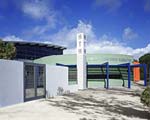 (Tom Bonner) Bright colors and bold signage create a distinct identity for High Tech High-LA.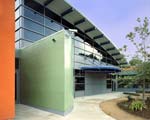 (Tom Bonner) Windows in the arching commons overlook the outdoor study garden, which includes an amphitheatre and an outdoor stage defined by a blue metal overhang.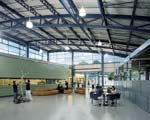 (Tom Bonner) The light-filled commons is the heart of the school; the space can be reconfigured to accommodate small-group work or all-school assemblies.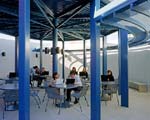 (Tom Bonner) Students work on wireless laptops in this outdoor classroom, which also serves as a casual gathering space and lunch spot.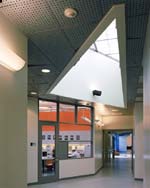 (Tom Bonner) Skylights usher in generous amounts of natural light, reducing reliance on artificial light.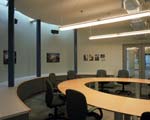 (Tom Bonner) A circular conference room, inspiration by corporate research centers, fosters the fluid exchange of ideas.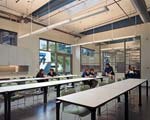 (Tom Bonner) All classrooms have direct access to outdoor spaces; many feature adjoining project rooms to store ongoing projects.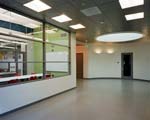 (Tom Bonner) Glass partitions create a transparent environment, allowing teachers to monitor student activity while also giving them a sense of autonomy.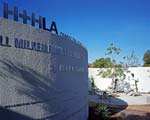 (Tom Bonner) High Tech High-LA received two-thirds of its funding from private donations and matching grants.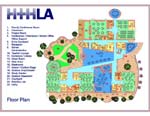 (Berliner and Associates, Architecture) Floor plan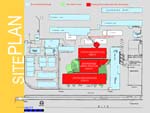 (Berliner and Associates, Architecture) Site plan |
© 2005 ArchNewsNow.com